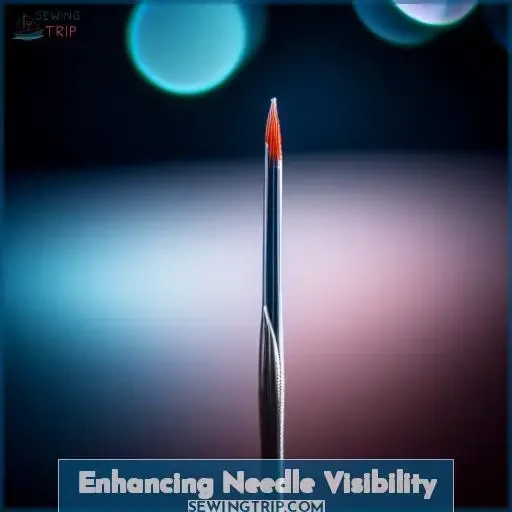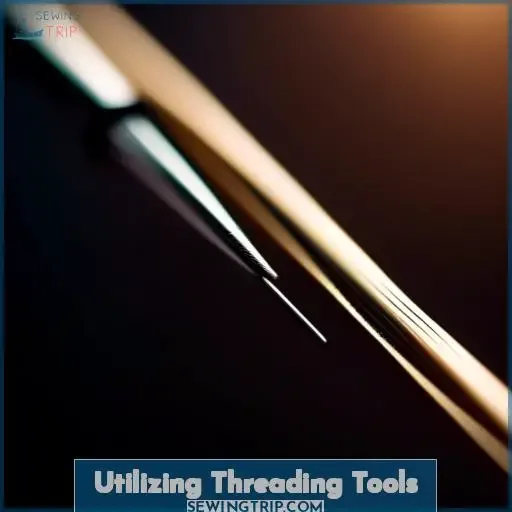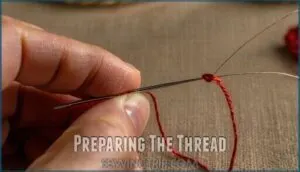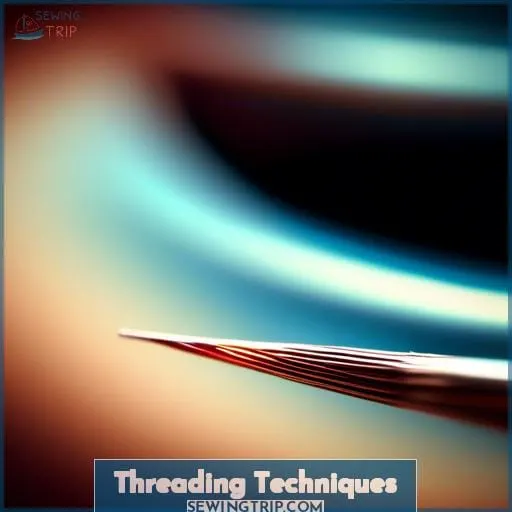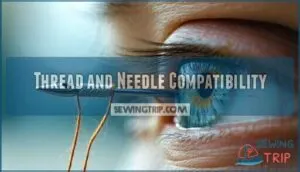This site is supported by our readers. We may earn a commission, at no cost to you, if you purchase through links.
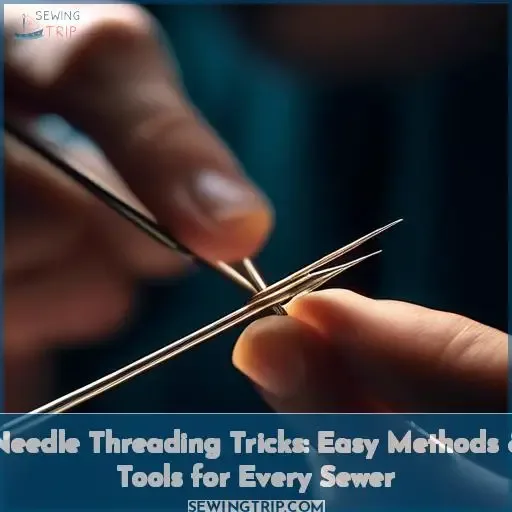
For many, this initial step can feel like a test of patience, but it doesn’t have to be.
This article dives into needle threading tricks, offering easy methods and tools that empower every sewer.
Whether you’re a seasoned tailor or picking up a needle for the first time, mastering these techniques will grant you the freedom to tackle any project with confidence.
Let’s unravel the secrets together.
Table Of Contents
Key Takeaways
- Enhance needle visibility by placing something white behind the needle, using white-out on the foot holder, employing a magnifier, ensuring adequate lighting, or using a needle threader.
- Prepare the thread properly by using sharp scissors for a clean cut, cutting the thread at a 45-degree angle, and dampening the thread’s end with water, saliva, or beeswax for easier threading.
- Utilize threading tools such as needle threaders, built-in needle threaders for sewing machines, tweezers for steadiness, and scissors for clean thread cuts to facilitate the threading process.
- Ensure thread and needle compatibility by matching thread size to needle size, considering the needle’s point size and thread quality, ensuring the needle’s eye size is compatible with the thread thickness, and being aware that material composition and shape variations can affect threading.
Enhancing Needle Visibility
You’ll find threading your needle much easier by placing white behind it.
Adding white-out on the foot holder also boosts visibility, making the task a breeze.
Place White Behind the Needle
When threading a needle, the struggle is real, but here’s a trick that’ll have you feeling like a sewing ninja:
- Snag a piece of white paper; it’s your new best friend.
- Slide it behind the needle; watch the eye pop with contrast colors.
- Shine a light source just right, and bam! The eye’s a clear target.
- If you’re still squinting, grab a magnifier and zoom in on victory.
With your needle placement on point, you’ll thread like a pro—no more eyeing the eye of the needle with dread!
Add White-out on the Foot Holder
After placing white behind the needle to boost visibility, let’s kick it up a notch with white-out on the foot holder.
This trick is a game-changer, especially if you’re working with light-colored foot holders. Applying a dab of white-out creates a stark contrast, making the needle’s eye pop like a star in the night sky.
Think of it as your secret weapon in the battle of needle threading. It’s a simple yet effective technique that turns threading up from a frustrating chore into a piece of cake.
So, grab your embroidery thread and let these needle threading tricks transform your sewing experience.
Utilizing Threading Tools
You’ll find threading needles much easier with the right tools.
Needle threaders like the Assorted Colors Plastic and Singer Pack of 3, along with built-in options and tweezers, offer steadiness and convenience.
Needle Threaders: Assorted Colors Plastic and Singer Pack of 3
After boosting needle visibility, grab your gotta-have-help tool: the needle threader.
These little lifesavers, with their plastic construction and wire flexibility, bridge the gap between thread and needle’s eye.
Singer’s pack or the assorted colors set, both ensure thread compatibility and easy storage.
They’re not just handy; they’re a stitch in time, saving you from the eye-straining tedium of sewing and embroidery threading methods.
Built-in Needle Threaders
Let’s talk built-in needle threaders—your sewing machine’s unsung hero. Imagine threading needles with the ease of a hot knife through butter.
- Built-in needle usage: like having a co-pilot in your sewing escapades.
- Thread tension adjustment: keep your stitches in line, no sweat.
- Compatible needle types: a match made in sewing heaven.
- Needle storage options: keep ’em handy, avoid the scramble.
- Advanced threading techniques: level up your threading game.
Tweezers for Steadiness
In the quest for threading mastery, tweezers become your secret weapon. They offer unmatched control, letting you hold that pesky thread steady with precision. Think of them as your if-all-else-fails method, turning frayed thread ends into a fresh, damp end ready for the pinch and fold method.
| Tool | Superpower |
|---|---|
| Tweezers | Precision hold |
| Scissors | Clean cut |
| Needle | The gateway |
| Thread | The challenger |
| Patience | Ultimate ally |
Embrace the power of tweezers; they’re not just for plucking anymore.
Preparing the Thread
Before threading your needle, ensure a clean cut on the thread using sharp scissors.
To prevent fraying and maintain control, stiffen the thread’s end with water, saliva, or beeswax.
Cutting Techniques: Sharp Scissors and 45-degree Angle
To enhance the quality of your sewing, pay attention to the thread you use. A high-quality thread ensures better stitching and reduces the risk of thread unraveling. The thread color should complement your fabric, and the thread stiffness should match the project’s requirements.
For example, a stiff thread is ideal for embroidery, while a soft thread is suitable for delicate fabrics.
When cutting the thread, use sharp scissors to ensure a clean cut. Cutting at a 45-degree angle helps prevent shredding and makes it easier to thread the needle. If you’re having trouble with thread stiffness, dampen the end of the thread to make it more pliable.
Stiffening Methods: Water, Saliva, Beeswax
Ready to conquer thread stiffening? Think of it as your secret weapon for smooth sailing through needle eyes.
Ditch the frustration of dry threading and embrace water, saliva, or beeswax. A quick dip or swipe can transform your thread from a floppy mess to a sharp spear, ready to pierce through with ease.
Whether you’re a beginner in embroidery or honing your techniques, this trick is a game-changer. No more wrestling with knots or begging the thread to cooperate. Just stiffen, aim, and pull through.
Welcome to the next level of embroidery mastery.
Threading Techniques
You’ve got options when it comes to threading your needle.
Try wetting the end of the thread.
Use the fold and pinch method.
Or opt for a self-threading needle.
Wet the End of the Thread
After prepping your thread, let’s tackle threading.
If you’re using embroidery floss, remember, its weight can be a handful. For a smooth start, wet the end—this stiffens it up, making it less like wrestling a noodle through a needle’s eye.
Needle types vary, so match the eye size to your thread.
Now, pinch that thread, and with a fold-and-pinch, you’re set to sew!
Fold and Pinch Method
Ready to master the fold and pinch method? Here’s the scoop:
Cut your thread at a sharp angle for control.
Next, fold it over the needle’s eye, and pinch the life out of it between your thumb and forefinger.
Now, with a magician’s flair, slide the needle over the loop and—voilà!—the thread pops through like a champ.
Say goodbye to squinty-eyed struggles and hello to threading triumph!
Self-threading Needles
Transitioning from the fold and pinch method, let’s tackle self-threading needles—a real game-changer.
- Align the thread with the needle’s top slot.
- Press down; the thread snaps into place.
- Feel the triumph of a threaded needle.
- Say goodbye to squinting and frustration.
Embrace the power of self-threading needle types and thread like a boss!
Thread and Needle Compatibility
Choosing the right thread size for your needle is crucial for smooth sewing.
Ensure the needle’s eye size matches the thread to avoid frustration and breakage.
Thread Size and Needle Size Considerations
After mastering threading techniques, let’s dive into the nitty-gritty of thread and needle compatibility.
Think of your thread and needle as a dynamic duo; their harmony is crucial. A mismatch can lead to a battle with thread tension, compromised thread strength, or even needle breakage.
Ensure your needle’s point size is a perfect match for your thread quality. A sharp needle paired with high-quality thread is your ticket to sewing success.
The Importance of the Needle’s Eye Size
Continuing from our chat about thread and needle size, let’s dive into the needle’s eye size. It’s a game-changer! Think of needle geometry as the unsung hero of your sewing saga.
- Thread thickness and eye compatibility are like a dance duo; if one trips, the performance flops.
- Material composition and shape variations in needles can turn a frustrating threading attempt into a smooth glide.
- Remember, the right match makes all the difference, turning ugh moments into aha! victories. Keep these tips in your toolkit and watch your sewing skills soar!
Frequently Asked Questions (FAQs)
How can I prevent thread tangling while sewing?
To avoid the dreaded tangle, wax your thread with beeswax.
Keep it short—elbow to hand length—and let it dangle to unwind after each stitch.
What is the lifespan of a needle threader?
A needle threader’s lifespan can be a bit of a gamble. With gentle use, they might last a while.
Can beeswax affect thread color or fabric?
Nearly 75% of crafters don’t realize beeswax can darken thread colors over time, especially on lighter fabrics.
It’s a game of risk and reward, adding durability but potentially altering your masterpiece’s intended hues.
How to thread a needle without sight?
To thread a needle without sight, wrap the thread around your finger. Then, rub the needle’s eye over it. Like magic, it threads itself! It’s a game-changer, making you a threading wizard in no time.
Are there eco-friendly alternatives to plastic threaders?
Imagine threading your needle with a whisper of history and sustainability.
Eco-friendly threaders, crafted from bamboo or recycled metals, offer a nod to tradition while empowering your craft.
They’re not just tools; they’re statements.
Conclusion
Threading a needle is like finding the keyhole in the dark; once you’ve got it, the possibilities shine bright.
With these needle threading tricks up your sleeve, you’re set to dive into sewing projects with ease.
Keep your threads trimmed, your needles matched, and your hands steady. Now, go forth and let your creativity flow through the eye of the needle.

